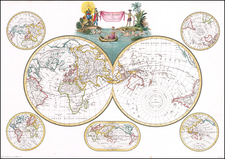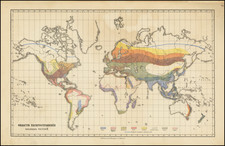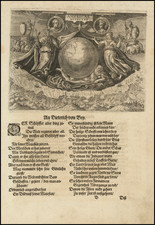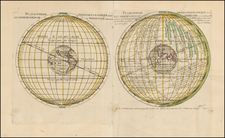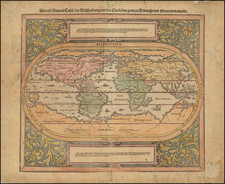Nice old color example of the first edition of Ortelius' famous world map.
Ortelius' world map is one of the most important and widely disseminated maps of the second half of the 16th century, forming the base model for a number of other contemporary maps. The present example is from the earliest state of the map, which can be identifed by the signature of the engraver, Fransciscus Hogenbergus (Franz Hogenberg) below the Cicero quote (center right) and the lack of any evidence of cracking in the lower left part of the plate.
The map is drawn from Gerard Mercator's 1569 wall map of the World, Gastaldi's 1561 world map and Diego Gutierrez' portolan map of the Atlantic. On the verso, Ortelius mentions in his Catalogus Auctorum that he also apparently had access to and drew upon the world maps by Peter ab Aggere from Mechelen, Sebastian Cabotus from Venice, Laurentius Fries from Antwerp, Jacobus Gastaldi, Gemma Frisius from Antwerp, Guicciardinus from Antwerp, Doco ab Hemminga Frisius, and Orontius Finæus from Paris.
The coastline of South America includes the extra bulge, which would be removed in state 2 (1585). Both the Northwest and Northeast Passages are shown quite boldly, although based completely upon myth and conjecture. A massive Terra Australis Nondum Cognita is shown with equally bold conjecture in the Southern Hemisphere. South America is shown in its potato configuration, as is the case in the first edition of this map. An elongated Northwest Coast of America is shown, along with Anian. Civola is shown, along with Quivira. Includes several sea monsters, a sailing ship and other decorative embellishments.
A nice old color example.
Abraham Ortelius is perhaps the best known and most frequently collected of all sixteenth-century mapmakers. Ortelius started his career as a map colorist. In 1547 he entered the Antwerp guild of St Luke as afsetter van Karten. His early career was as a business man, and most of his journeys before 1560, were for commercial purposes. In 1560, while traveling with Gerard Mercator to Trier, Lorraine, and Poitiers, he seems to have been attracted, largely by Mercator’s influence, towards a career as a scientific geographer. From that point forward, he devoted himself to the compilation of his Theatrum Orbis Terrarum (Theatre of the World), which would become the first modern atlas.
In 1564 he completed his “mappemonde", an eight-sheet map of the world. The only extant copy of this great map is in the library of the University of Basel. Ortelius also published a map of Egypt in 1565, a plan of Brittenburg Castle on the coast of the Netherlands, and a map of Asia, prior to 1570.
On May 20, 1570, Ortelius’ Theatrum Orbis Terrarum first appeared in an edition of 70 maps. By the time of his death in 1598, a total of 25 editions were published including editions in Latin, Italian, German, French, and Dutch. Later editions would also be issued in Spanish and English by Ortelius’ successors, Vrients and Plantin, the former adding a number of maps to the atlas, the final edition of which was issued in 1612. Most of the maps in Ortelius' Theatrum were drawn from the works of a number of other mapmakers from around the world; a list of 87 authors is given by Ortelius himself
In 1573, Ortelius published seventeen supplementary maps under the title of Additamentum Theatri Orbis Terrarum. In 1575 he was appointed geographer to the king of Spain, Philip II, on the recommendation of Arias Montanus, who vouched for his orthodoxy (his family, as early as 1535, had fallen under suspicion of Protestantism). In 1578 he laid the basis of a critical treatment of ancient geography with his Synonymia geographica (issued by the Plantin press at Antwerp and republished as Thesaurus geographicus in 1596). In 1584 he issued his Nomenclator Ptolemaicus, a Parergon (a series of maps illustrating ancient history, sacred and secular). Late in life, he also aided Welser in his edition of the Peutinger Table (1598).










